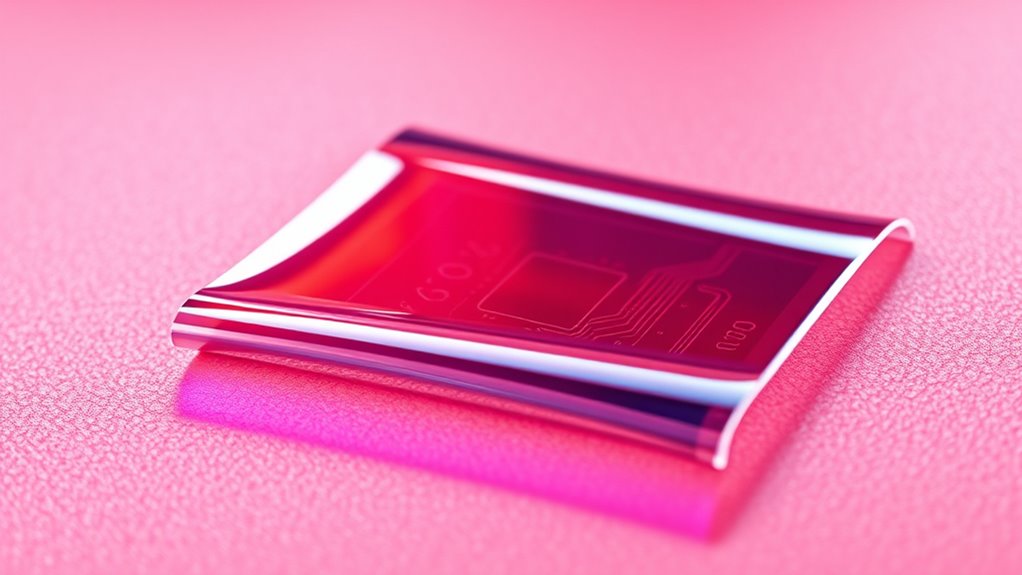Flexible electronics let you enjoy gadgets that can fold, bend, and stretch to fit your lifestyle. These devices include lightweight, bendable screens, flexible batteries, and wearable displays that conform perfectly to your body or clothing. They’re durable, portable, and create a seamless experience, blending technology with fashion and functionality. As these innovations advance, you’ll discover even more ways to integrate flexible electronics into daily life, making your gadgets smarter and more adaptable than ever before.
Key Takeaways
- Flexible electronics include gadgets like foldable smartphones, bendable tablets, and wearable displays that conform to various shapes.
- These devices use thin, lightweight, bendable screens and batteries for seamless integration with the body or clothing.
- Advances in flexible batteries ensure reliable power during movement, enabling continuous use of foldable and stretchable gadgets.
- Future innovations combine flexible displays and energy sources, leading to versatile devices such as foldable tablets and smart clothing.
- Flexible electronics enhance user comfort and durability, transforming how we interact with technology in everyday life.

Flexible electronics are revolutionizing the way we interact with technology by making devices more adaptable and durable. Imagine wearing a screen that contours seamlessly to your wrist or arm, providing real-time information without the bulk of traditional gadgets. That’s where wearable displays come into play, transforming the way you access data on the go. These displays are thin, lightweight, and bendable, so they can fit comfortably on your body or integrate into clothing and accessories. Whether it’s a flexible smartwatch or a health monitor embedded in your clothing, wearable displays make technology more accessible and less obtrusive. They open up new possibilities for fitness tracking, augmented reality, and instant notifications, all while maintaining a sleek, comfortable profile.
Flexible displays transform wearable tech with lightweight, bendable screens that fit seamlessly onto your body for real-time data access.
To keep up with the demands of these flexible devices, engineers have developed flexible batteries that can bend, twist, and stretch without losing their power. Unlike traditional rigid batteries, flexible batteries are designed with flexible substrates and electrodes, allowing them to conform to various shapes while providing reliable energy sources for wearable displays and other gadgets. These batteries are thin and lightweight, making them ideal for integration into clothing, accessories, or other flexible electronics. They guarantee that your wearable devices operate smoothly during daily activities, even when you’re moving or stretching. As flexible batteries become more efficient and durable, they enable new applications in health monitoring, sports, and entertainment, making your gadgets more resilient and longer-lasting. Additionally, ongoing research into AI-powered nanobots suggests that future flexible electronics could incorporate nano-scale components for enhanced functionality.
The combination of wearable displays and flexible batteries makes flexible electronics incredibly versatile. You could have a fitness band that wraps around your arm, showing your heart rate, step count, and notifications, all powered by a flexible battery that moves with you. Or imagine a flexible tablet that folds in half when not in use, easily slipping into your pocket or bag. As these technologies improve, they’ll become more integrated into everyday life, blurring the line between fashion and function. You might soon wear clothing with embedded displays that change patterns or display messages, all powered by flexible batteries tucked discreetly into seams.
In essence, flexible electronics are shaping a future where gadgets are no longer confined to rigid frames but adapt to your lifestyle and environment. Wearable displays and flexible batteries are at the forefront of this revolution, making devices more resilient, portable, and user-friendly. As advancements continue, you’ll find yourself with smarter, more comfortable tech that moves with you, enhancing your daily experiences in ways you never thought possible.
Frequently Asked Questions
How Durable Are Flexible Electronics Under Repeated Bending?
When you ask about durability under repeated bending, it depends on the material’s fatigue resistance and bending resilience. Good flexible electronics are designed to withstand many cycles without breaking or losing function. You’ll find that advanced materials and engineering improve resilience, reducing material fatigue. So, with proper design and high-quality materials, these gadgets can endure extensive bending, making them reliable for daily use and flexible applications.
What Materials Are Used to Create Flexible Electronic Components?
You might think creating flexible electronic components is impossible, but thanks to material innovations, it’s actually a reality. You’ll find materials like conductive polymers, graphene, and flexible substrates like polyimide, which enable bending without breaking. Advanced manufacturing techniques, such as printing and layering, help craft these components seamlessly. These innovations make your gadgets more adaptable, durable, and ready to bend to your will, transforming how you interact with technology daily.
Are Flexible Gadgets Safe for Long-Term Skin Contact?
You might wonder if flexible gadgets are safe for long-term skin contact. Generally, they are designed with biocompatible materials to minimize skin irritation. However, prolonged use could still cause irritation or allergies in sensitive individuals. it is crucial to monitor your skin’s response and follow manufacturer guidelines. While most are safe, long-term safety varies based on materials used and personal skin reactions, so stay attentive to any discomfort.
Can Flexible Electronics Be Recycled or Are They Environmentally Friendly?
You’re probably surprised to learn that only about 15% of electronics get recycled, highlighting significant recycling challenges. Flexible electronics, with their complex materials, pose similar issues, making their environmental impact a concern. While some components can be reused, most aren’t easily recyclable, leading to e-waste buildup. To reduce this impact, manufacturers are exploring eco-friendly materials and recycling methods, but it’s clear flexible gadgets still need better solutions for long-term sustainability.
How Do Flexible Devices Impact Battery Life and Power Efficiency?
Flexible devices often improve battery performance and power efficiency because their design reduces energy consumption through optimized components and materials. You’ll notice longer battery life, as flexible electronics can adapt to your usage patterns and minimize energy waste. Their innovative architecture allows for better heat management and lower power needs, helping you enjoy extended device usage while reducing environmental impact. Overall, flexible gadgets are shaping more efficient, eco-friendly tech experiences.
Conclusion
So, next time your phone bends a little or your smartwatch stretches with you, don’t be surprised. Flexible electronics are making gadgets more adaptable than ever—literally. It’s amusing to think that in the future, your devices might fold into your pocket or stretch with your workout, all while still working perfectly. Who knew that bending the rules of electronics could make life so much more flexible? Looks like the future’s got a bendable sense of humor.









